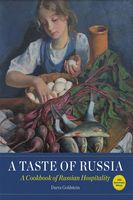From the Pantry
Preserving Nature’s Gifts
Published 1983
The Russian pantry of old was a wonderland of sights and smells. In the cool air the pungent odor of smoked meats and pickled vegetables blended with the nutty scent of milled grains and the sweet fragrance of dried apricots and apples and pears. Shimmering jars of fruit preserves and brandies reflected all manner of conserves displayed on shelves along the facing wall. In a rear corner stood large oaken tubs brimming with mochonye yabloki (apples soaked in brine) and sauerkraut put up with caraway and other spices. Deep vats held cucumbers and mushrooms in various guises: salted heavily or lightly; pickled in vinegar; marinated in aromatic oils. Wild field mushrooms were strung on ropes and hung to dry in orderly profusion, accompanied by garlands of dried cherries and plums and other summer fruits. Coarse, heavy sacks of salt and wheat flour were in easy reach by the door, as were sparkling cones of crystal sugar. There were bins of buckwheat groats for kasha and hulled wheat for kut’ya; bins of buckwheat flour for blini and rye meal for black bread. Bags of dried beans were clustered in one section of the room. Butter was stored in a glazed tub in the “dairy corner,” along with a variety of homemade cheeses, both hard and soft. The cottage cheese, tvorog, was hung in muslin bags to solidify over drip pans. Sides of ham and home-cured bacon were suspended from the rafters, as were sausages in fanciful shapes—links, rounds and tubes. Ropes of garlic and onions dangled in the air. Sometimes whole salted watermelons were piled high on the floor. Root vegetables, such as turnips and horseradish, lay buried in sand in a long, low box to remain fresh throughout the winter. A special area was set aside for the preparations of fish, especially sturgeon: balyk, the cured fillet; and vesiga, the gelatinous backbone, necessary for the perfect kulebyaka. Sturdy wooden shelves lined the room, and row upon row of fruit preserves, jams and jellies greeted the eye, each jar beckoning, promising delight. There were strawberries from the field and from the garden, simmered over a slow fire to rich thickness or suspended in brandy. Golden peaches floated in their own syrup or in a compote with other fruits. Bright tomatoes and peppers kept company in jars of baklazhannaya ikra (eggplant caviar). There were sweet, viscous syrups to use in baking and fruit drinks; glistening garnet and amber homemade brandies and liqueurs; vinegars and mustards steeped with wild herbs. This well-stocked larder was integral to every household in the days when a party of twenty or more might unexpectedly drop in for a refreshing meal.
In this section
Advertisement
Advertisement


